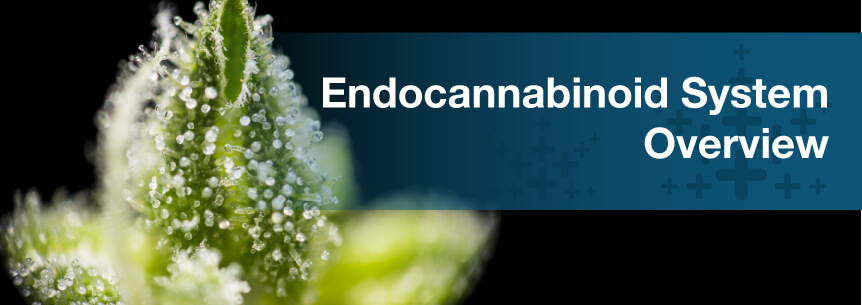
The endocannabinoid system plays an incredibly important role in your overall health and maintaining homeostasis and balance in your body. It’s a complex system responsible for regulating your body’s immune response, metabolism, memory, appetite, communication among cells and more.
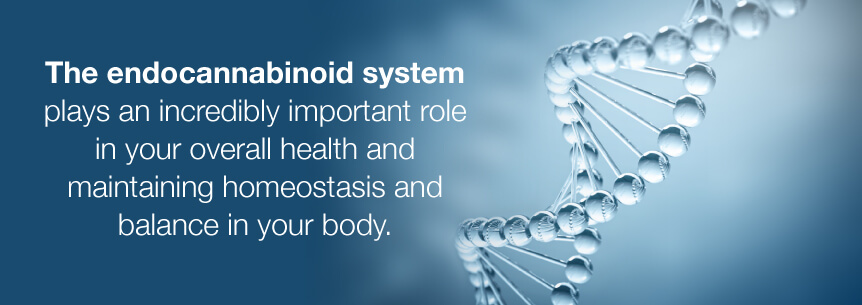
However, despite its integral role in the functions of the human body, its operation and impact weren’t completely understood. Its significance is only now becoming better understood by the medical and scientific communities.
The endocannabinoid system is what enables the naturally occurring cannabinoids in medical marijuana to interact with your body and trigger the positive effects of cannabis. As research moves forward, scientists and medical professionals are now turning to how marijuana affects your physical health, your mind and your body’s cells and systems.
The biological endocannabinoid system performs a significant job in your body. It also plays a role in the psychological and physical effects of marijuana. While studying the effects of cannabis, scientists stumbled upon this system and gave it its name for this reason.
The term “Endo” stands for “Endogenous,” meaning “originating in your body.” A cannabinoid is the compound group which activates this system.
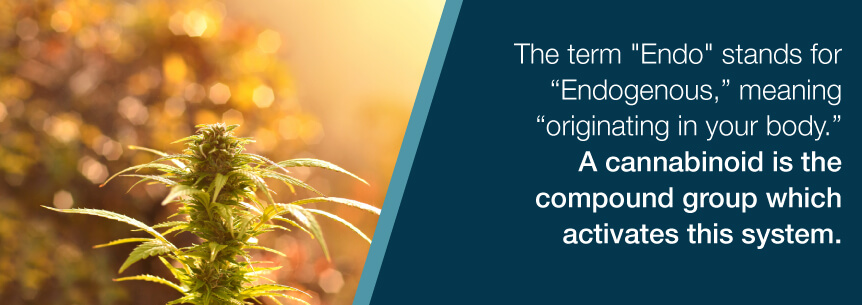
Because the ECS has widespread therapeutic effect potential, it’s a focus of medical research. Although researchers and scientists have discovered a lot about this system, there’s still more research needed, which continues today.
The ECS is a group of cell receptors and equivalent molecules. Consider cell receptors like tiny locks on your cell surfaces. Chemical molecules known as agonists provide the keys for these locks. When agonists bind to cells, they relay messages and give cells directions. The ECS’s two main cell receptors are CB1 and CBS. Each one responds in its own way to different cannabinoids.
You have CB1 receptors throughout your body — particularly in your spinal cord and brain. They’re mainly located in areas associated with certain behaviors they impact, such as in your hypothalamus, which pertains to regulating your appetite, and the amygdala, which relates to emotional and memory processing. You also have CB1 receptors in your nerve endings, where they’re involved in reducing the sensation of pain. CB1 receptors are mostly found in your central nervous system and provide you with benefits such as:
You’ll find CB2 receptors mostly on immune system cells and your peripheral nervous system. Once the activation of these receptors occurs, they begin an immune response of working to reduce damage to tissue and inflammation thought to play a significant role in the immune response of your body to certain medical conditions and diseases. Some cells have both receptor types.
Your body naturally produces endocannabinoids all the time. Consuming cannabis increases their concentration in your body.
Your ECS helps regulate major functions in the body, including:
Despite the important role the endocannabinoid system takes on, which we understand a little better now, it was an unknown actor in the human body until rather recently.
Endocannabinoid activity has the main role of maintaining a stable internal environment even with external environment changes. This stability is referred to as homeostasis. Using numerous mechanisms, such as facilitating intercellular communication between various types of cells, endocannabinoids regulate homeostasis.
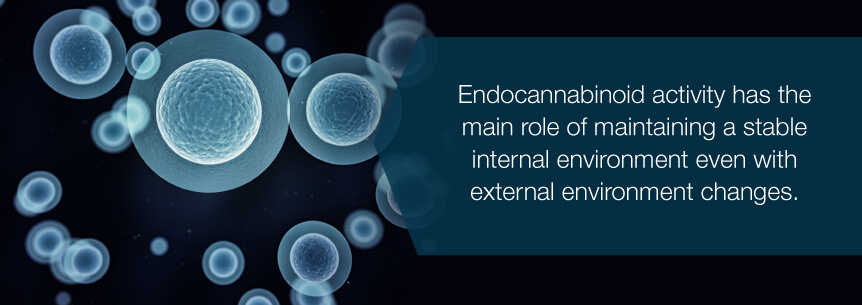
Homeostasis is the process of actively regulating biological systems to keep conditions within a confined range. For instance, your body doesn’t want a too-cold or too-hot temperature. It also doesn’t want a too-low or too-high blood pressure level, either. To maintain optimum cellular performance, conditions must be “just right.”
Let’s take another example. At an injured area, you’ll find cannabinoids reducing the release of sensitizers and activators from the injured tissue, keeping the nerve cell stabilized to avoid too much firing. This calms the neighboring immune cells and prevents pro-inflammatory substance release. These actions on cells are for one purpose: to reduce the damage and pain the injury causes.
Neurotransmitters typically flow to postsynaptic neurons from presynaptic neurons. Endocannabinoids are different and can flow in the reverse direction to provide the presynaptic cell with feedback. Endocannabinoids maintain homeostasis mainly because of this process. For instance, if a neuron is rapidly firing messages, the endocannabinoids give the instruction to travel upstream to slow down and activate presynaptic CB1 receptors.
Your body has cannabinoid receptors all through it and they have a huge range of functions. But there are specific receptors compiled in certain areas. CB1 receptors are plentiful in your central nervous system, while the CB2 receptors are more bountiful in your peripheral nervous system and the gastrointestinal tract on immune cells.
With your endocannabinoid system a branch of medicine all its own, and with the multiplicity of receptor areas in the body, it goes to show how significant endocannabinoids are for daily functioning. They assist in regulating things like:
Endocannabinoids are your body’s chemical messengers. They tell it when to start these processes and when to stop them. They help in maintaining maximum balance in your body. If something disrupts your ECS, it can lead to any of these processes falling out of balance. Researchers believe ECS dysregulation contributes to several conditions, including irritable bowel syndrome and fibromyalgia.
Aside from balancing basic functions, your ECS also responds to illness. For instance, research shows tumor cells, compared to healthy cells, express more cannabinoid receptors. Studies also indicate an increase in the level of endocannabinoids in patients who have specific ailments like anxiety, arthritis, Parkinson’s disease and chronic pain.
The key pieces of the ECS emerged from evolution quite a while ago and now appear in all vertebrate species. The ECS’s three key components are:
Cannabinoid receptors sit on cell surfaces and “listen” to outside cell conditions. They deliver changing conditions feedback to the inside of the cell, activating the relevant cellular response.
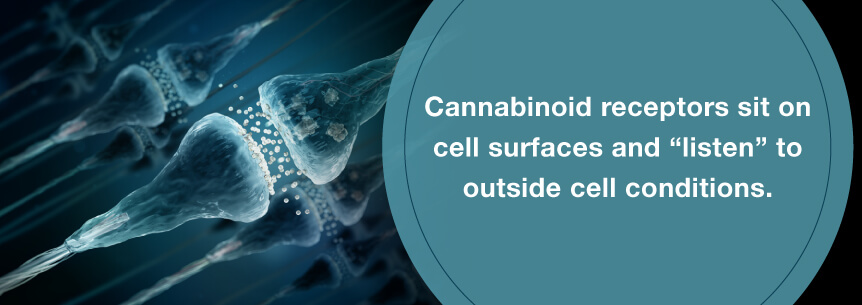
As mentioned, there are two primary cannabinoid receptors: CB1 and CB2. While not the only ones, they are the first receptors discovered and the most thoroughly studied. A large number of CB1 receptors are in the brain and interact with THC, which gets people “high.” There is a large number of CB2 receptors outside your nervous system in areas like your immune system. Both receptors, however, are all over the inside of your body.
Endocannabinoids, similar to THC, bind to and activate cannabinoid receptors. But the cells in your body produce endocannabinoids naturally, unlike THC. There are also two primary endocannabinoids:
These are produced in your cell membranes from fat-like molecules. Your body synthesizes them on-demand, meaning, as you need them, your body makes and uses them, as opposed to being packaged and stored for use at a later time like numerous other biological molecules.
Scientists discovered anandamide in 1992 and resolved that they were the CB1 receptor’s endogenous ligand. Anandamide’s chemical structure is quite similar to THC’s. Researchers discovered 2-AG in 1995. It activates both receptors, CB1 and CB2, unlike anandamide.
Both 2-AG and anandamide are synthesized from an Omega-6 fatty acid, arachidonic acid, even though the specific synthesizing enzymes and pathways vary. Fatty acid amide hydrolase (FAAH) degrades anandamide and monoacylglyceride lipase degrades 2-AG. Cell membranes produce both of these as needed using precursor molecules.
Metabolic enzymes destroy endocannabinoids rapidly once they use them. The two large enzymes, MAGL and FAAH, ensure the endocannabinoids are used on-demand, but for no longer than needed. This differentiates endocannabinoids from your body’s other molecular signals like your classical neurotransmitters and hormones.
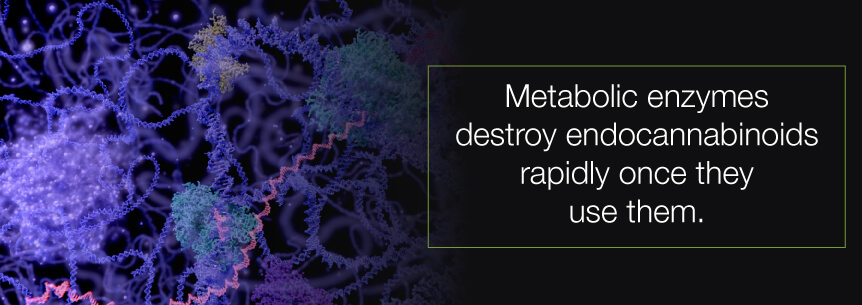
Many people consume marijuana because of its mind-altering effects. Others, however, use it to relieve their symptoms. However, if your body didn’t have a biological system already interacting with THC and other active chemical compounds, cannabis wouldn’t provide its therapeutic effects or get you high.
This is exactly what your endocannabinoid system does. But it’s not there just for you to indulge in your favorite strain’s effects. It also serves an important health purpose, since it regulates essential biological aspects.
Since researchers discovered the ECS and its parts, they’ve been working hard to understand how to use the ECS therapeutically to:
Overall, research shows the ECS helps ensure the central nervous and immune systems work properly. Finding methods to regulate the ECS’s activity opens pathways to a fascinating group of chronic disorders and diseases. For instance, stimulating cannabinoid receptors could help delete traumatic memories and could therapeutically benefit age-related disorders linked with brain inflammation.
Specific ways the endocannabinoid system affects your health include in the areas of:
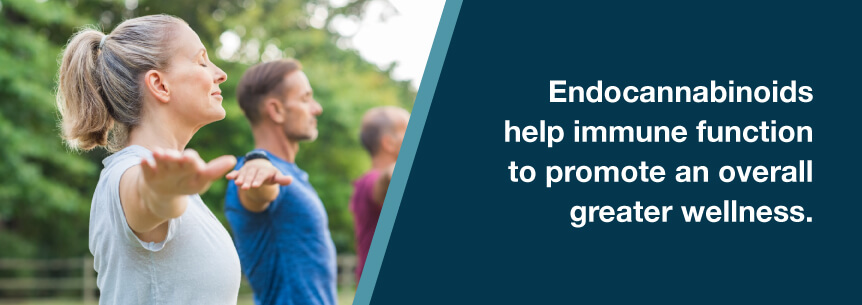
An obstacle for some in accepting medical marijuana as well as the active cannabinoids it contains is wondering whether or not there’s a risk of abuse because of its psychoactivity. It’s an understandable concern, with its potential to alter the mind, but there are numerous approaches to regulate the ECS:
THC and other phytocannabinoids from medical cannabis or hemp’s concentrated CBD do affect the ECS. But the receptors pick up non-psychoactive phytocannabinoids derived from different plants or even flavonoids, terpenes and other compounds in our endocannabinoid systems.
Since phytocannabinoids in small doses may encourage your body to produce its natural endocannabinoids along with their receptors, it could potentially strengthen our native system’s sensitivity to standard cannabinoid supplements.
In general, substantial research is still needed for researchers to understand the endocannabinoid system’s impact on our overall health and how using plant-based cannabinoids to supplement our natural production of endocannabinoids could play a substantial therapeutic role in our health.
As scientists and researchers continue learning more about the ECS, they also study the possible role THC, CBD and other cannabis-derived cannabinoids could play in providing support for the system. Cannabinoids copy endocannabinoid behavior and have interactions with cannabinoid receptors to improve the ECS. With this cannabinoid receptor interaction, they stimulate numerous physiological responses.
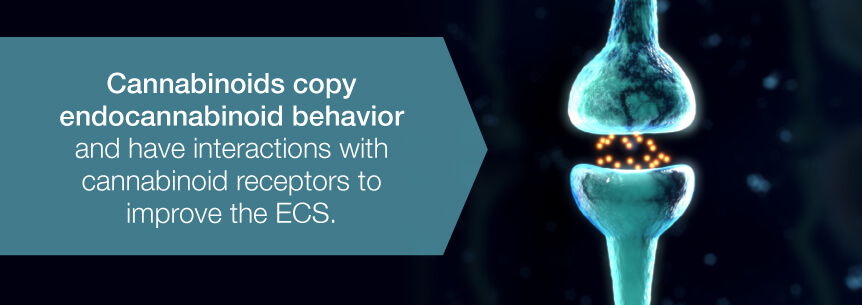
Being the natural chemical messenger of your body, cannabinoids fall into two main categories:
Neurons (brain cells) send chemical messages to communicate with one another as well as your entire body. These messages help regulate and coordinate all the things you do, feel or think. Usually, a neuron (presynaptic cell) releases neurotransmitters, which travel across the synapse (small gap) and attach themselves to certain receptors found on a neighboring postsynaptic cell starting the neuron to receive the message to take action. This triggers a group of actions, passing the message along.
However, the ECS communicates its messages differently, since it works in reverse. Once there’s activation of the postsynaptic neuron, cannabinoids are produced on-demand from fat cells (lipid precursors) already in the neuron. The cell then releases them and they make their way in reverse to the presynaptic neuron, attaching themselves to cannabinoid receptors.
This process is important because the cannabinoids acting on presynaptic cells may control the next action with the activation of these cells. Cannabinoids limit how much neurotransmitter is released, affecting the sending, receiving and processing of the messages by the cell.
To understand how medical marijuana can trigger beneficial effects for many ailments, treatment side effects and more, you have to learn about what THC and CBD, two of the most common cannabinoids, are, and how they interact with the endocannabinoid system.
This well-known psychoactive compound is also in cannabis and activates receptors to get a chemical response. It’s a CB1 and CB2 receptor agonist, since it binds and activates the receptors directly. THC favors CB1 receptors, since it fits in them well and stimulates a good physiological reaction.
When CB1 receptors and THC react together, it causes the “high” sensation you get from cannabis. THC activates CB2 receptors directly — however, it’s only a partial agonist and doesn’t produce that strong a physiological response.
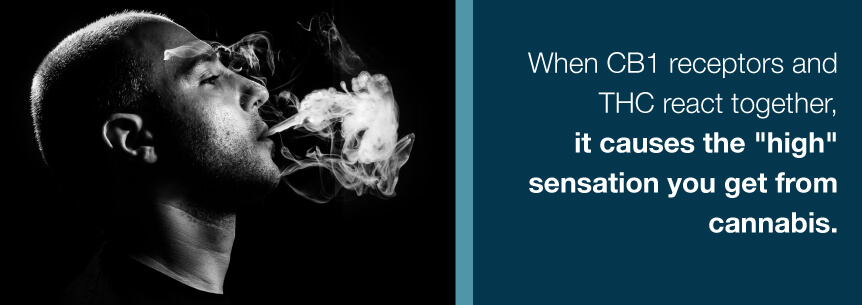
When you smoke cannabis, the THC takes over your ECS and rapidly attaches to the cannabinoid receptors in your body and brain. When this happens, it interferes with the natural cannabinoids’ ability to work as they’re supposed to — regulating the communication between the neurons — and, therefore, throws your whole system off-balance.
THC’s effects are wide-ranging, since cannabinoid receptors are located throughout many areas of your body and brain. These effects include:
THC also affects the areas of your brain causing you to feel good, which accounts for the “high” you experience. With time, however, THC changes the functioning of your ECS in those areas of your brain, causing problems with addiction, memory and mental health.
Studies show that since THC binds with both CB1 and CB2 receptors, it activates them in a similar fashion to how an endocannabinoid would. These are commonly psychological effects, but THC doesn’t stop at just getting you high. It also helps with:
It helps with a lot of other things as well, like dealing with cancer and its treatment side effects.
CBD doesn’t bind to any receptors. Instead, it inhibits the FAAH enzyme that slows down and prevents anandamide breakdown — potentially the most crucial endocannabinoid in your body. It leads to anandamide building up in your brain.
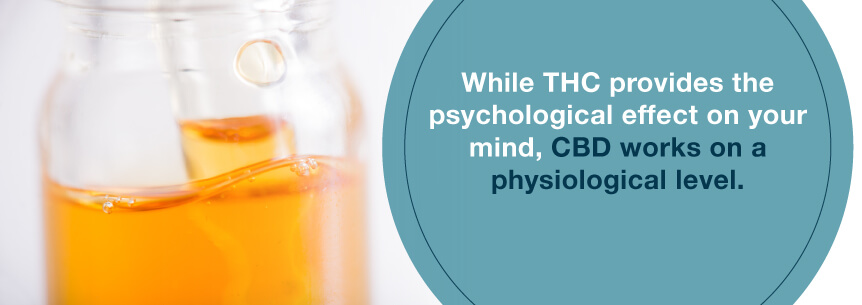
While THC provides the psychological effect on your mind, CBD works on a physiological level. It provides numerous medicinal benefits scientists and researchers are now discovering in earnest. However, it is well-known for helping treat various severe medical illnesses like:
It’s also an antipsychotic, a painkiller against neuropathic pain and muscles spasms and an anti-anxiety agent.
CBD blocks receptors, causing chemical changes. It works as an indirect antagonist of agonists, meaning it sits inside the receptors imperfectly and doesn’t activate them, but prevents THC and other chemical messengers from binding to them.
Evidence shows CBD combined with THC provides the best results. Various studies emphasize the therapeutic benefits of combining THC and CBD — especially for the treatment of peripheral neuropathy (a cancer-linked and painful condition), diabetes, arthritis, multiple sclerosis (MS) and other neurodegenerative disorders.
Patients can learn how terpenes and certain cannabinoids offer therapeutic benefits for targeting various ailments and diseases. Patients suffering from epilepsy, for instance, might want to use a low-THC, high-CBD strain to reduce their incidence of seizures while not producing psychoactive effect potentially interfering with their work, school or family life.
We all know the profound influence cannabis has on the human body. The therapeutic compounds this one herb contains affect not just our minds and bodies, but our health as well — and in a positive way.
For more information on the endocannabinoid system and how medical cannabis can help you, search for a medical marijuana doctor or locate a cannabis dispensary. Experts are standing by to help you find a doctor, get your medical marijuana card and choose the best endocannabinoid system and marijuana treatment for your ailment.